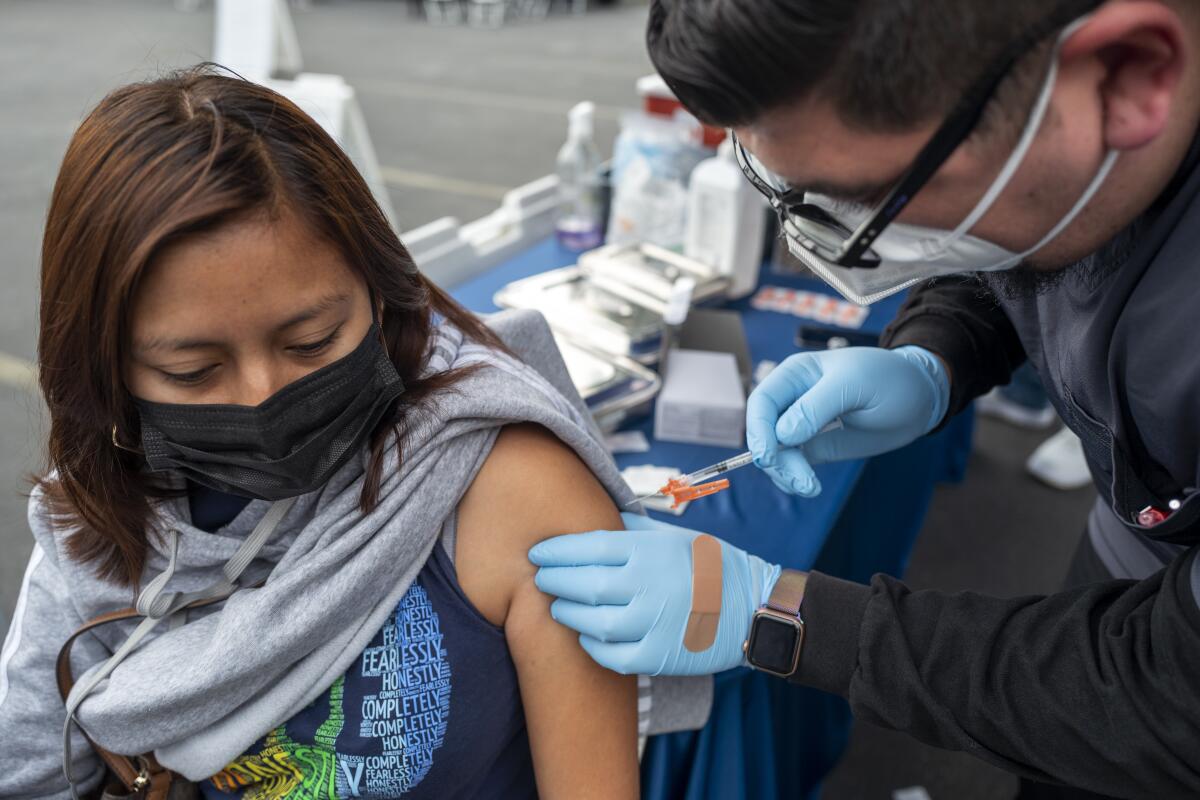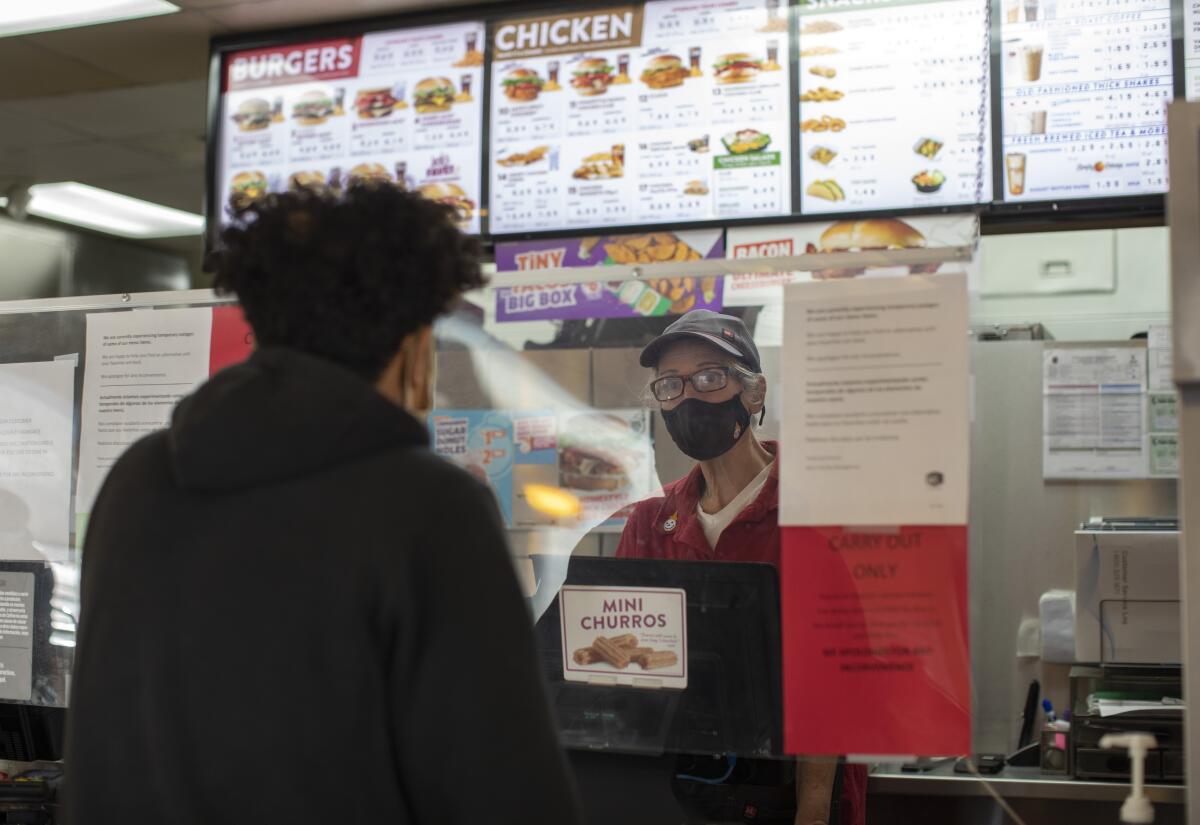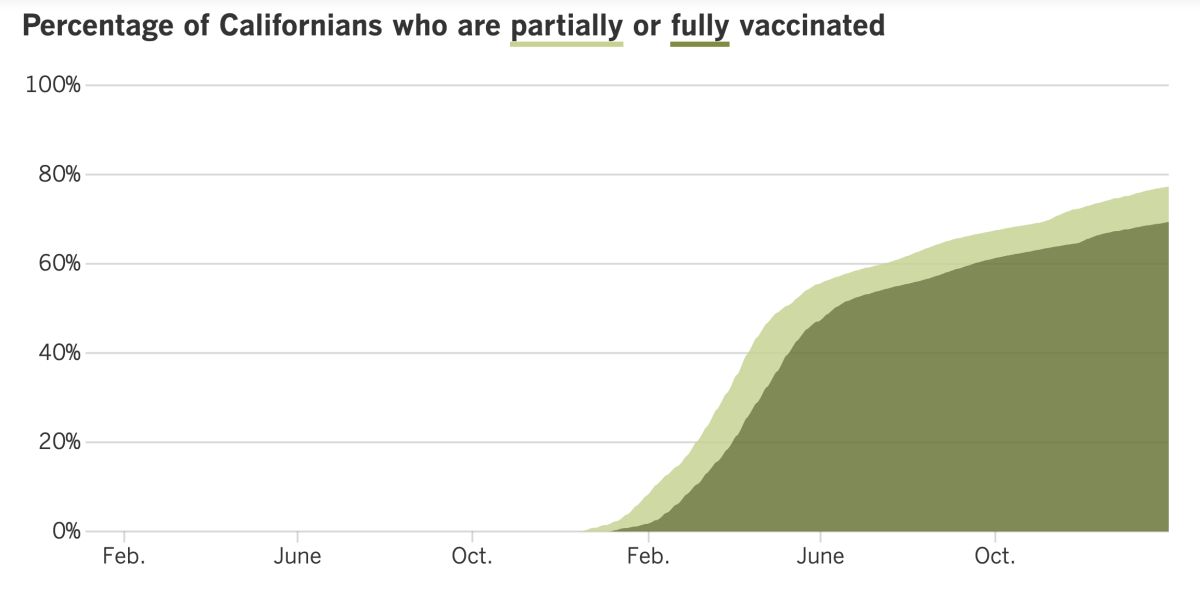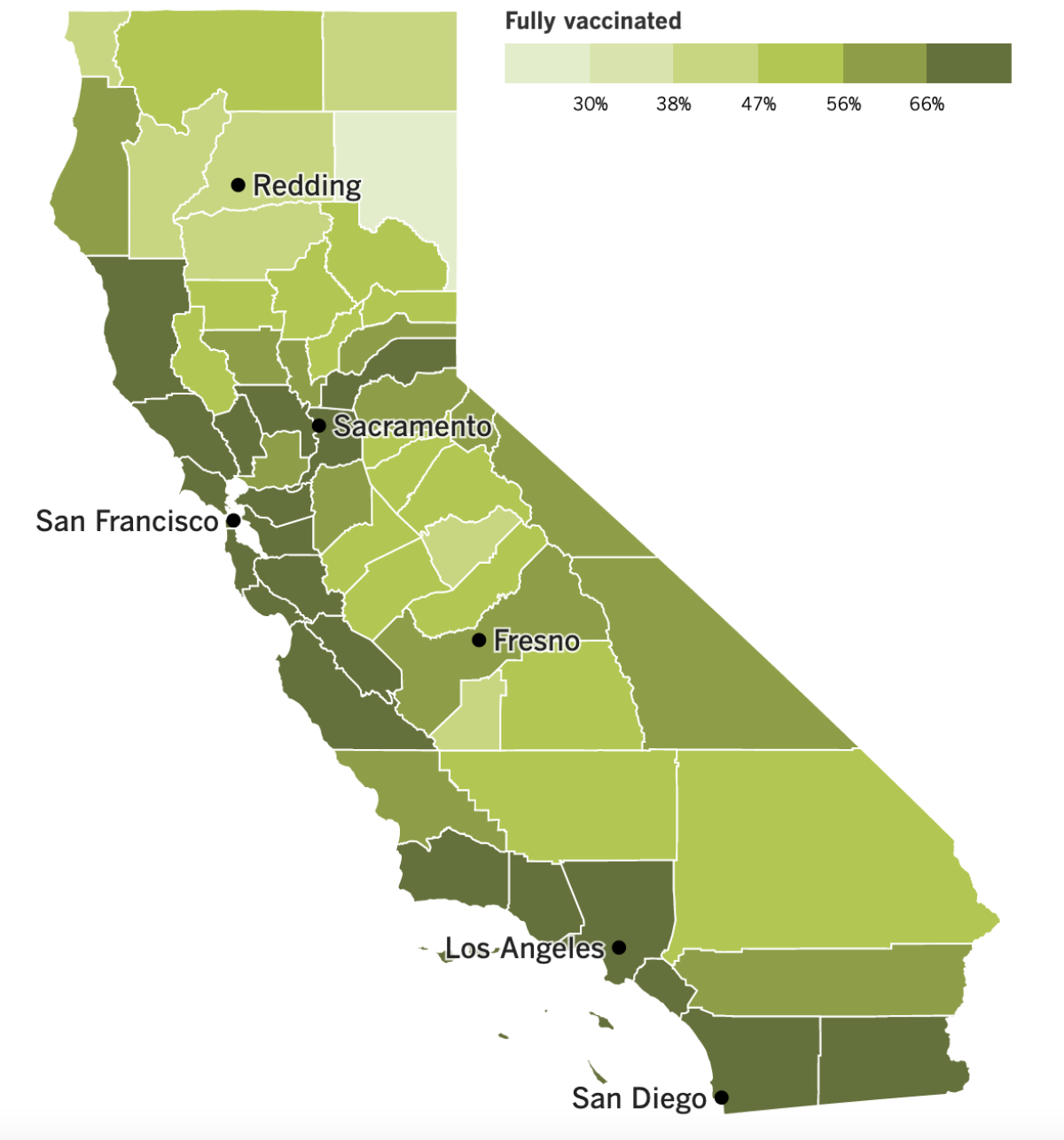Coronavirus Today: What the Bay Area teaches us about the value of vaccines
Good evening. I’m Karen Kaplan, and it’s Tuesday, Feb. 1. Here’s the latest on what’s happening with the coronavirus in California and beyond.
Considering how readily the Omicron variant spreads, a lot of people have been wondering whether COVID-19 vaccines are still of any use. To answer this question, let’s take a look at the COVID-19 death tolls in Southern California and the San Francisco Bay Area.
The southern part of the state recorded more than 2,400 COVID-19 deaths in January, when Omicron dominated the coronavirus landscape. That’s equivalent to 10.6 deaths per 100,000 residents.
The Bay Area, meanwhile, had just over 300 COVID-19 deaths last month. That works out to 3.7 deaths per 100,000 residents.
What accounts for the fact that the COVID-19 death rate was nearly three times higher in Southern California than in the Bay Area? Vaccines.
“Because of our high vaccine rate, and because of our booster rate, we are not in a situation like other parts of the country that have lower vaccination rates, where there are very high numbers of death, where they’re not able to staff their hospitals adequately,” Dr. Grant Colfax, San Francisco’s director of health, said at a recent Board of Supervisors meeting.
He’s not the only one who thinks vaccines deserve the credit, my colleagues Rong-Gong Lin II and Luke Money report.
The difference in death rates in the two parts of the state “can largely be accounted for by these important differences in percent [of people] vaccinated and boosted,” said Dr. Eric Topol, director of the Scripps Research Translational Institute in La Jolla. “Undoubtedly, other factors contribute, but their impact is likely much less.”

In Los Angeles County, 69.8% of all residents are fully vaccinated, and 46.4% of them have gotten a booster shot, according to the Centers for Disease Control and Prevention. In Orange County, those figures are 69.8% and 50.2%. They’re lower in San Diego County and the Inland Empire — only 56.7% of Riverside residents and 55.6% of those in San Bernardino County are fully vaccinated, CDC data show.
Travel north a few hundred miles and you’ll find that 82% of San Franciscans are fully vaccinated and 63.9% of them are boosted. In Santa Clara County, the most populous county in the Bay Area, 84.1% are fully vaccinated and 57.9% of them are boosted.
With higher vaccination and booster rates, the Bay Area experienced fewer coronavirus cases in January, and that lower case rate resulted in a lower COVID-19 death rate, said Dr. Robert Kim-Farley, an epidemiologist at UCLA.
This shouldn’t be all that surprising. Health officials and other experts have told us a time or two that the best way to reduce one’s risk of developing a severe — or fatal — case of COVID-19 is to get up to date with COVID-19 vaccinations. In early January, Californians who were unvaccinated were 6.9 times more likely to be hospitalized with COVID-19 and 16.9 times more likely to die of the disease compared with Californians who were fully vaccinated, according to the state Department of Public Health.
And compared with Californians who are fully vaccinated and boosted, those who are unvaccinated are 22 times more likely to die of COVID-19, the health department says.
A team from the L.A. County Department of Public Health published a report Tuesday in the CDC’s Morbidity and Mortality Weekly Report that compared COVID-19 hospitalization rates among unvaccinated, vaccinated and vaccinated-and-boosted residents. If you look at Figure 1, you’ll see a graph that shows hospitalizations have always been higher for unvaccinated individuals, but the gap took off like a hockey stick about a week after Omicron became the dominant coronavirus strain.
Here’s another way of looking at it: If everyone in L.A. County had been up to date with their vaccinations and boosters, the number of hospitalized COVID-19 patients during the Omicron wave through mid-January would have been 98% lower than it actually was, according to modeling estimates from researchers at USC. Surely, that would have translated into many fewer deaths as well.
By the numbers
California cases and deaths as of 5:35 p.m. on Tuesday:

Track California’s coronavirus spread and vaccination efforts — including the latest numbers and how they break down — with our graphics.
Coming to work with COVID-19
In a perfect world, people with COVID-19 would stay home from work until their infections cleared so they wouldn’t spread the coronavirus to others. The same goes for people who have COVID-19 symptoms but haven’t been able to confirm their diagnosis with a test.
But as the pandemic is so adept at showing us, we don’t live in a perfect world. And people like Maria Bernal are cajoled into showing up for work anyway.
“Don’t worry, everyone has it, you can still work,” Bernal’s boss told her, according to a complaint she filed with Sacramento County’s public health department. “Just wear a mask and don’t tell anyone.”
So Bernal showed up for her shift at a Jack in the Box in Folsom, Calif. Her head felt heavy, her hands were shaking from chills, and her vision was too blurry to read the orders on her screen.
Three of her co-workers also alleged that managers at the fast-food restaurant talked people out of following the advice of public health officials, which is to isolate yourself if you are sick or quarantine if you could be contagious but aren’t yet sick yourself.
Instead, the workers were advised to report for duty and hide their symptoms from their fellow employees. Some people with COVID-like symptoms even worked without masks, even though this defies a statewide indoor mask mandate, a statewide workplace mask mandate, and plain old common sense.
Bernal’s co-worker Crystal Orozco said in the complaint that she texted her manager to say she had a cough and a fever. She suspected COVID-19 but couldn’t get her hands on a test to find out for sure. The manager’s response: Show me a doctor’s note. That was a no-go, because Orozco doesn’t have health insurance.
A Jack in the Box spokesman told my colleague Suhauna Hussain that franchises are required to follow federal, state and local health and safety requirements related to COVID-19, though they can set their own sick leave policies and safety protocols. The company is “actively investigating the concerns raised,” he said.

It’s not just fast-food workers who are being pressured to show up for work with COVID-19. So are people who work in retail, at grocery stores, in warehouse distribution centers and in child-care centers.
A child-care provider in Las Vegas told her boss she had been exposed to someone with the coronavirus and wasn’t feeling well herself, even though she had been vaccinated. Her boss told her to come in because the center was short-staffed. So after a detour to a COVID-19 testing site, she reported for duty.
Realizing the results of her PCR test might take a few days to come in, she picked up a rapid test on her way home. She tested positive.
The woman was out for a few days, and when she returned, her bosses asked her to keep quiet about the fact she had come to work with COVID-19, exposing her colleagues and the children in their care. As far as management was concerned, once she was recovered and able to work, there was no need to tell others what had happened, the woman said.
Stories like these are not uncommon, said Kristen Harknett, a professor of social behavioral sciences at UC San Francisco who has polled service sector workers during the pandemic.
“A lot of workers feel pressure to come in — a supervisor is leaning on them, saying, ‘I really need you today,’” Harknett said.
Two-thirds of those surveyed toward the end of last year said they’d gone to work while feeling ill. Without adequate sick leave, they may have felt they had no choice, Harknett said. And when a situation like the Omicron surge threatens to leave businesses short-staffed, the pressure to come in can be overwhelming.
Workers say the CDC inadvertently added to this pressure by shortening the minimum recommended isolation time for people with coronavirus infections from 10 days to five.
Those forced to come to work sick aren’t the only ones unhappy about this trend. Hussain spoke to a CVS employee in L.A. who was out for nearly two weeks after she, and then her daughter, came down with COVID-19. As per company policy, she only got paid for five sick days. Though she stayed home, she fears that some of her co-workers will come back to work before they’ve recovered if they run out of paid sick days.
“Five days is not good enough,” she said.
California’s vaccination progress


See the latest on California’s vaccination progress with our tracker.
Your support helps us deliver the news that matters most.
In other news ...
The San Francisco 49ers weren’t the only losers at Sunday’s NFC championship game against the Rams at SoFi Stadium on Sunday. Gov. Gavin Newsom, Los Angeles Mayor Eric Garcetti and San Francisco Mayor London Breed had some explaining to do after they were photographed at the game without masks on their faces. The photos were posted on Twitter by former Laker Earvin “Magic” Johnson (who was also maskless).
To be fair, the Rams’ “FanCam” spied Garcetti and Newsom with their masks on while seated. Representatives for the mayor and governor said they wore their masks for most of the game but removed them briefly to mug for the camera.
It didn’t take long for anti-mask groups and other critics to cry foul. L.A. County requires masks to be worn by everyone — regardless of vaccination status — at large events except while eating and drinking. SoFi Stadium’s own mask policy states masks can be removed only to eat or drink.
L.A. County Supervisor Kathryn Barger had a different reaction to the photos. Instead of accusing the politicians of hypocrisy, she called on public health officials to rescind their mask mandates.
“I strongly believe individuals should be allowed to make an informed choice about whether to mask up or not,” Barger said in a statement. “Let’s do away with blanket COVID-19 masking policies — they don’t make a difference when they’re not consistently followed or enforced.”
L.A. County Public Health Director Barbara Ferrer begged to differ. Just because people may not comply with the mask order 100% of the time doesn’t mean the solution is to get rid of it altogether, she said.
“That would be like eliminating speed limits because so many drivers ignore them and feel that they can assess for themselves the safe speed for their travel,” she said.
On a less contentious note, L.A. County’s nursing homes have managed to avoid setting new records for daily COVID-19 deaths even as Omicron sent case numbers to unprecedented heights. Deaths did increase during the Omicron wave, but that increase was relatively small, county health officials said.
Daily COVID-19 deaths as of mid-January occurred at a rate of 20 per 100,000 nursing home residents. That was roughly one-quarter the rate seen during the pandemic’s opening salvo in the spring of 2020, and it was one-fifth the rate at the peak of last year’s winter surge.
Here’s some more good news: The U.S. Food and Drug Administration has upgraded Moderna’s COVID-19 vaccine from emergency use authorization to full approval.
More than 200 million doses of the vaccine have been administered to American adults over the last 13 months, and that real-world experience bolstered the case for approving the shot, which will now be sold under the brand name SpikeVax. The vaccine is only available for adults; the FDA has delayed a decision on authorizing it for teens while it studies the risk it poses for heart inflammation.
Pfizer and BioNTech have COVID-19 vaccines available for children as young as 5, and a version aimed at infants, toddlers and preschoolers may be available as early as March. The two companies have been testing a shot for children ages 6 months to 4 years, and the FDA urged them to apply for emergency use authorization earlier than they had planned. That happened Tuesday.
The vaccine for the youngest children contains one-tenth the dose given to adults. In clinical trials, two doses were enough to protect babies but not enough for preschoolers. Three doses are now being tested, with results expected in late March. In theory, the FDA could start by authorizing two doses and then allow a third shot later if the data support it.
The FDA’s vaccine advisory group will discuss the shots at a meeting on Feb. 15. Once the shot clears all FDA hurdles, the Centers for Disease Control and Prevention will have to sign off on it as well.
The leader of the World Health Organization shared an amazing statistic Tuesday: Since the Omicron variant was first identified just after Thanksgiving, the world has recorded 90 million new coronavirus cases. That’s more cases in 10 weeks than were reported during all of 2020.
And finally, we have an update on Spotify’s policies on COVID-19 misinformation. In a blog post, the CEO of the popular streaming service acknowledged it hadn’t been as clear as it could have been. To improve, the company published its internal content moderation policies and introduced a new labeling system for content related to COVID-19.
“It’s become clear to me that we have an obligation to do more to provide balance and access to widely accepted information from the medical and scientific communities guiding us through this unprecedented time,” wrote CEO Daniel Ek.
But he didn’t mention the service’s star podcaster Joe Rogan or his show “The Joe Rogan Experience.” Rogan has come under fire for saying disparaging things about COVID-19 vaccines, promoting bogus COVID-19 “treatments” and inviting guests who espouse discredited conspiracy theories.
Rock legend Neil Young brought the issue to a head last week when he pulled his music off Spotify. “I am doing this because Spotify is spreading false information about vaccines — potentially causing death to those who believe the disinformation being spread by them,” Young wrote in a letter to his management team and record label. Other artists followed suit.
Rogan himself addressed the controversy Sunday night with a pledge to spend more time researching topics he discusses on his show and doing a better job of balancing different perspectives. He said he was fine with Spotify’s plans to put a disclaimer on his podcasts to warn listeners when his guests have opinions that challenge the consensus of doctors and scientists.
“I will do my best to try to balance out these more controversial viewpoints with other people’s perspectives, so we can maybe find a better point of view,” Rogan said in a video statement. “I want to show all kinds of opinions so that we can all figure out what’s going on and not just about COVID, but everything about health, fitness, wellness, the state of the world itself.”
Your questions answered
Today’s question comes from readers who want to know: How can I tell whether a COVID-19 testing site is legit?
I’m not here to make you paranoid about getting scammed at a testing site, but no less an authority than California Atty. Gen. Rob Bonta has warned that people are trying to take advantage of vulnerable folks who just want to know whether they have a coronavirus infection. My colleague Karen Garcia has this advice for determining whether a pop-up testing site is the real deal:
- Visit the state Department of Public Health’s online search tool and see if the site is listed there. The COVID-19 website for your county probably has a list of testing sites as well. (L.A. County’s site is here.)
- Look for a sign with the county logo and the name of the company running the test site.
- Consider the location of the testing site. No legitimate site in L.A. County will be set up on a sidewalk. Instead, you can expect to find them in settings like schools, parks, churches and community centers such as YMCAs.
- Authorized testing sites in L.A. County do not perform rapid antigen tests, so if that’s what’s being offered, it’s a red flag. Real sites only use nasal swabs to collect specimens for PCR tests.
- Expect to be asked for your name, date of birth, your health insurance company and how you’d like to get your test results. The reason for knowing your health insurer is to send them the bill for your test — you will not be asked for money at a bona fide testing site.
- If you suspect a case of fraud, ask to see a worker’s healthcare credentials. You can also ask for the name of the laboratory that processes the tests and the codes that will be used to bill the insurer for the tests.
- If you’re asked to provide your Social Security number, to share your nationality or immigration status, or to flash your driver’s license or passport when you have other documentation of health insurance, something fishy is going on. Ditto if you notice misspellings or unusual names in the test provider’s web address, or you see spelling mistakes on forms that ask for personal information.
- Be wary of unsolicited calls or texts from purported testing sites. Don’t provide any personal information until you’re sure the call or text is from an authorized testing provider.
If this advice comes too late and you think you’ve already been scammed, you can file an online complaint with the state attorney general’s office or call the inspector general for the U.S. Department of Health and Human Services at (800) 447-8477.
We want to hear from you. Email us your coronavirus questions, and we’ll do our best to answer them. Wondering if your question’s already been answered? Check out our archive here.
Resources
Need a vaccine? Here’s where to go: City of Los Angeles | Los Angeles County | Kern County | Orange County | Riverside County | San Bernardino County | San Diego County | San Luis Obispo County | Santa Barbara County | Ventura County
Practice social distancing using these tips, and wear a mask or two.
Watch for symptoms such as fever, cough, shortness of breath, chills, shaking with chills, muscle pain, headache, sore throat and loss of taste or smell. Here’s what to look for and when.
Need to get a test? Testing in California is free, and you can find a site online or call (833) 422-4255.
Americans are hurting in many ways. We have advice for helping kids cope, resources for people experiencing domestic abuse and a newsletter to help you make ends meet.
We’ve answered hundreds of readers’ questions. Explore them in our archive here.
For our most up-to-date coverage, visit our homepage and our Health section, get our breaking news alerts, and follow us on Twitter and Instagram.




